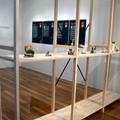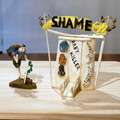Dennis Griffin began constructing this series of models in January 2011. Carved out of bone and stone, the models were part of his healing process and means for Griffin to express how he felt soldiers were treated after returning from Vietnam.
Griffin served with Victor 2 Company 1RNZIR for six months, returning to New Zealand from his Tour of Duty in 1968. He spent the next 40 years living with crippling feelings of rejection, his initial pride in serving for his country tarnished by the rejection he felt directed towards those returning from Vietnam. There was an expectation, according to Griffin, that returning soldiers should:
...forget the war, be silent and let time pass so that we could once more be accepted into society, as if we had done something to be ashamed of...
He says these models helped him reconcile his feelings of betrayal and lift the burden of rejection, and each one represents a different stage of Griffin's journey. The first model depicts a proud Christian soldier leaving to serve New Zealand. The next two portray the same soldier returning home to rejection by his country and church, weighed down by shame and embarrassment.
This load shifts following the redress and apology from the New Zealand Government, Army, and RSA in 2008 – Griffin's models represent a soldier able to unload some of his burden; pride and honour restored. The last model in the series is a soldier with his arms in the air, free to make peace with his past, and those who previously rejected him.
Look at images of Dennis Griffin's models in the Home Fires Burning exhibition below:
Manatū Taonga Ministry for Culture & Heritage. Material from the Home Fires Burning: New Zealand's Vietnam War exhibitions held in Papakura, Auckland, April-June 2012










